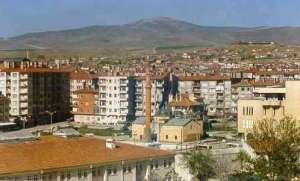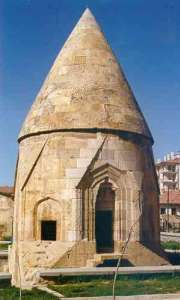Kırşehir
 The research and excavations of the recent years have shown that human
settlements in Kırşehir started in 3000 B.C. Ceramic pieces from that period are found
in the tumuluses of Kırşehir. The archaeological excavations undertaken at Hashöyük, a
village of the central district of Kırşehir, in 1930 by Turkish and Italian
archaeologists has revealed pieces of pottery from 3000 B.C. The research and excavations of the recent years have shown that human
settlements in Kırşehir started in 3000 B.C. Ceramic pieces from that period are found
in the tumuluses of Kırşehir. The archaeological excavations undertaken at Hashöyük, a
village of the central district of Kırşehir, in 1930 by Turkish and Italian
archaeologists has revealed pieces of pottery from 3000 B.C.
In 2000 B.C we see the start of Assyrian Trade Colonies period and the Hittite period.
Two altars with cow heads from Old Hittite Period brought to the Hirfanlı Dam Operations
from the shores of the Kızılırmak River, Malkayası with
hieroglyph inscriptions and known as Hittite road inscription located between the villages
of Sevdiğin and Kale, also the seals, ceramic kitchen utensils, public buildings with
walls etc found at Kaman Kale Tumulus are important traces of the Hittite period.
Current archaeological excavations and surface investigations also reveal that, after
the Old and Late Hittite Periods, the Old and Late Phrygian Periods were also lived in a
most dense fashion. In 550 B.C, Anatolia was completely under Persian dominance. Within
this period, Kırşehir was part of the Central Anatolia history, a region which became
well known as Cappadocia (Beautiful Horses). As Persians
sufficed with only military invasion of Anatolia , significant ruins or remains cannot be
found in Kırşehir, but Persian seals were found at excavations of the Kaman Kale
tumulus. Persian dominance came to end in 334 BC when the armies of Alexander the Great came to Anatolia and defeated the Persians.
Kırşehir and environs experienced severe pressures due to lack of authority during the
period of the Cappadocia Kingdom which was established in 333 BC. In the year 18, Roman
Emperor Tiberius officially annexed Cappadocia to the Roman Empire and converted it into a
provincial status.
Roman period was a period of strong paganism as well as a period where Christianity was
fast expanding. About 15 underground cities of varying size are known to exist from that
period in Kırşehir, which were built as places of worship and sanctuary for the
Christians.
Historical research shows that Kırşehir was for a while an important political center
during the Roman period and even functioned as the provincial capital.
 There
is not much information about the Byzantine period of this area, but ruins and remains
indicate that a Byzantine period did exist. Üç Ayak church from the 10th century at
Taburoğlu village of the provincial center, which is one of the first big village
churches in Anatolia, was a church where Protestants and Catholics worshipped together,
and the church ruins at Fakıl village and Temirli are interesting. There
is not much information about the Byzantine period of this area, but ruins and remains
indicate that a Byzantine period did exist. Üç Ayak church from the 10th century at
Taburoğlu village of the provincial center, which is one of the first big village
churches in Anatolia, was a church where Protestants and Catholics worshipped together,
and the church ruins at Fakıl village and Temirli are interesting.
Seljuk period is significant for Kırşehir as it is for Anatolian Turkish history as a
whole, and worth investigating.
Urbanization of Kırşehir during the Seljuk period started in the early years of 13th
century. Kırşehir was given to one of the Emirs of the Mengücük dynasty, Melik
Muzaffererüddin Muhammed as a fief, who was defeated in battle by Seljuks at Erzincan,
for his outstanding performance. During his stay in Kırşehir, Melik Muzaffererüddin
Muhammed built the Melik Gazi Medrese (old theological school) in 1230.
Mongolians which invaded whole of Anatolia in 1240 after the Kösedağ defeat converted
Kırşehir into a rest stop for winter (kışlak) and a summer place in the
plateau (yaylak). The long lasting military presence of Mongolians in Kırşehir
turned it into an important political and military center.
 Nureddin
Cibril Bin Cacabey, who was appointed as Emir to Kırşehir in 1260's, started the first
significant construction activities of the Turkish period, thanks to the good relations he
established with the Mongolians. Cacabey Medrese which was one of the first schools of
astronomy and Cacabey Inn near Kızılırmak as well as numerous big and small buildings
were all realized during his times. Nureddin
Cibril Bin Cacabey, who was appointed as Emir to Kırşehir in 1260's, started the first
significant construction activities of the Turkish period, thanks to the good relations he
established with the Mongolians. Cacabey Medrese which was one of the first schools of
astronomy and Cacabey Inn near Kızılırmak as well as numerous big and small buildings
were all realized during his times.
In the 13th century, Ahi Evran which organized the Anatolian Turkish
union in general and the organization and unification of the trade and craftsmen in
particular, came to Kırşehir after Denizli, Konya and Kayseri and carried out his mission there, turning Kırşehir into
the center of the Ahi movement. After the leader Ahi Evran, Kırşehir sustained its
position as the center of the Ahi. The decisions taken at the lodge in Kırşehir were
influential from Azerbaijan to Bosnia-Herzagovina.
In 1293, Mevlana's son Sultan Veled sent ambassadors to certain centers in Anatolia,
with the aim of spreading the Mevlevi belief. The person assigned to Kırşehir was Şeyh
Süleyman Türkmani. Süleyman Türkmani established a lodge in Kırşehir and spread
Mevlevi belief from this base. His close relationship to Mevlana
and Mevlana's appreciation of him are apparent from his letters.
It is also known that Mevlana's son Alaaddin fled to Kırşehir after his name got
involved in the case of Şemsi Tebrizi murder in Konya. All this show that Kırşehir was
one of the important centers of the Mevlevis in Anatolia.
Hacı Bektaş-ı Veli, who came to Suluca
Karahöyük, received a great number of people there, who had a leaning towards his ideas.
Kırşehir continued to be one of the most important political, social and cultural
centers of Anatolia from 13th to the middle of the 15th century.
In the beginning of the 14th century, Famous Sufi Aşık Paşa who was
one of the prominent people which brought progress to Anatolia wrote his Garibnâme
of 12 thousand couplets. After Karamanoğlu Mehmet Bey who wanted to establish Turkish as
the official language, Aşık Paşa became the most important advocate of the Turkish
culture and brought it into the language of literature in the most successful way.
Great Sufi scholar Ahmet Gülşehri who translated Mantık-ut Tayr
by Ferideddin Attar who lived in Kırşehir into Turkish, is known as the greatest poet
after Yunus Emre.
In addition to all these, it is also speculated that Yunus Emre had lived in
Kırşehir, died there and his grave is on the ziyaret (Visit) Hill in the
Ulupınar District of Kırşehir.
Kırşehir Museum
The initial studies for the establishment of the Kırşehir Museum started in 1936.
This was the period of Post - Republic Turkey when initiatives for new museums were
strong. In Kırşehir a museum storage was formed by collecting certain stone works and
ethnographic pieces at Alaaddin Mosque situated on what people a mound at the city center
called the "castle" by the people. This initiative was soon forgotten until the
establishment of a Commission for Historical Heritage by the Governor in 1975 and the
Kırşehir Museum Directorate was established in 1980. The first listing of the coins was
undertaken in 1981 and field work was started for the listing of in situ items of the
future collection.
In 1985, the material collected so far was put on display in a 100 m² space at the
premises of the Provincial Culture and Tourism Directorate and a storage of 20 m² was
arranged. With the start of the Kaman Kale tumulus archaeological excavations, the growth
of the museum accelerated and in the same year first listing of the archaeological items
was started.
In 1993 the material of the museum were put into storage at the Kırşehir Cultural
center.
The work aimed at opening the museum to public accelerated in 1996. Kırşehir Museum
which is now open to visits has more than 3300 items consisting of coins and ethnographic
and archaeological materials.
Furthermore, the field work carried out by Kırşehir Museum Directorate has revealed
136 items of immobile cultural heritage and these were registered and taken under
protection
Museum Display
The lower floor of what formerly was Fine Arts Gallery within the Cultural Center was
opened to visits in 1997 as Archaeological Museum and a large section of the upper floor
as the Ethnography Museum.
The major part of the archaeological material are from the excavations and surface
investigations carried out in the region and from Kaman - Kale Tumulus and Malkaya in
particular. In the archeology section the findings of the Kaman Kale Tumulus excavations
are exhibited, which cover a period range in chronological order from the period of
Assyrian Trade Colonies to the Ottomans period.
In one corner of the hall, marble works from Roman period are grouped. Islam period
which starts with sarcophagus of children and grave stones, goes up to the Ottoman period
with coin window displays.
The major part of the second floor is arranged as an ethnography museum. There are
three display windows devoted to the Ahi institution which emerged from Kırşehir and
various items related to Ahis or about them, including a head gear which is claimed to
belong to Ahi Evran, the Ahi flag and various official documents and registers are
displayed in them.
There is a rug loom in a corner, representing the rug making tradition in Kırşehir
and a mannequin with local costumes weaving in front of the loom. In another corner there
is an exhibition of daily life at a typical Kırşehir house.
- Source:
- Turkish
Ministry of Culture
|